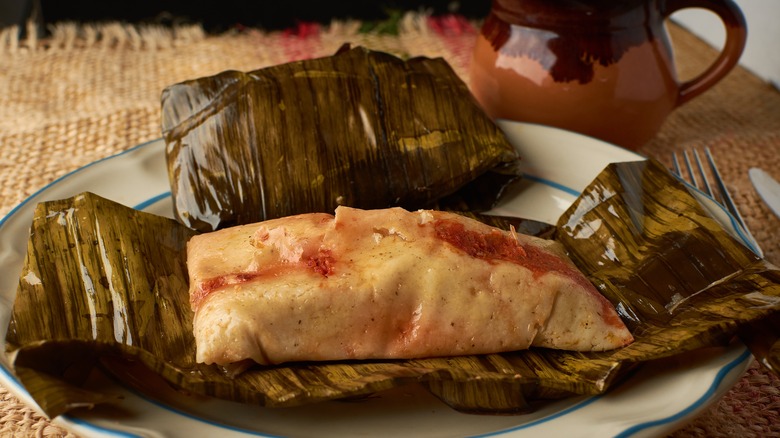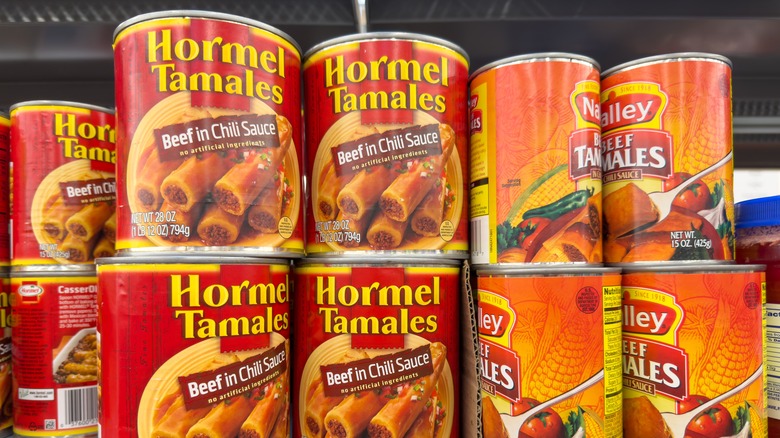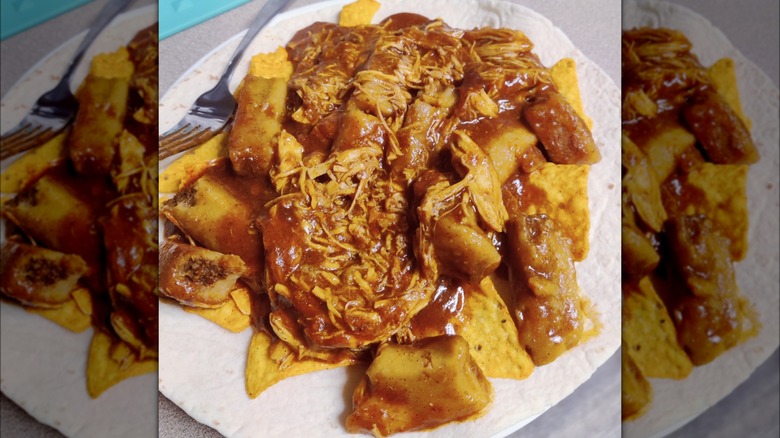Canned Tamales Are The Affordable Meal You Need To Stop Sleeping On
We may receive a commission on purchases made from links.
Are you craving tamales, but you're short on time? In this case, you might want to try the canned version. It's cheap, convenient, surprisingly healthy, and bursting with flavor. For example, Hormel Beef Tamales are made with real beef, tomatoes, water, corn meal, corn flour, masa flour, spices, and a pinch of cornstarch. These are pretty much the same ingredients you'd use for homemade tamales, depending on the recipe.
Traditionally, tamales consist of dough made from masa or corn. The dough is filled with meat, cheese, veggies, or fruits and steamed in corn husks or banana leaves. This delicious Pre-Columbian dish can be served as is or topped with sour cream, salsa, guacamole, or diced onions. If you prefer sweet tamales, top them with chocolate sauce, whipped cream, fresh berries, or cinnamon and sugar. There are so many ways to make tamales that a lifetime wouldn't be enough to try them all.
The problem is that most tamale recipes are time-consuming and require dozens of ingredients. You need to prepare the dough and filling, layer the ingredients, and then cook the whole thing. Plus, this dish tastes better the next day, so it's not the best choice for a quick lunch or dinner. With that in mind, you might want to try canned tamales on those days when cooking isn't an option.
Canned tamales are a fan favorite
Good tamales should have a moist and tender texture, with the filling distributed evenly. The corn husk should remain intact during cooking to hold the ingredients together. You'll also want to ensure the filling is flavorful and well-seasoned without overpowering the dough. The same goes for the topping or side sauce, which should have a subtle aroma that complements the other ingredients.
As surprisingly as it may seem, canned tamales tick most boxes. They don't have the same texture and visual appeal as the homemade version, but their flavor is rich and balanced. Some Amazon reviewers recount how they grew up eating canned tamales and they hold nostalgia for them. Others say they love to keep them handy for a quick and satisfying meal, and they like to experiment with different toppings and preparations for them. One person admits they aren't as good as homemade tamales, but they're still "very tasty."
A potential drawback is their high sodium content. For example, one serving of Hormel Beef Tamales has 990 grams of sodium or 2.5 grams of salt. That's about 66% of the sodium intake recommended by the American Heart Association. This ingredient acts as a preservative, inhibiting the growth of bacteria and other pathogens. Additionally, canned tamales are wrapped in waxy paper, which must be removed before you heat them.
This canned delight still requires some prep work
As it turns out, there's a right way to chow down on tamales. If you go with the canned version, you'll still have to do some prep work. First, open the can and transfer its contents to a plate. Remove the waxy paper around the dough (if applicable) and heat them on the stovetop, in the oven, or in the microwave. If you prefer to bake them, sprinkle some shredded cheese on top to enhance their flavor. Cook them at 350 degrees Fahrenheit for about 30 minutes.
If you're feeling creative, use canned tamales to make other dishes, such as a chili bake or casserole. Another option is to serve them with sautéed onions and peppers, cilantro lime rice, or black bean salsa. You can also top them with hot sauce, sour cream, or avocado slices. For a tangy flavor, slice two or three pickled jalapeños and sprinkle them on top.
Last, consider making canned tamales at home so you can enjoy them over several weeks. First, prepare the tamales as usual, and then put them in clean jars. Next, screw the lids tightly and transfer the jars to a pressure canner. Process them for an hour or so, let them cool, and store them at 50 to 70 degrees Fahrenheit. There's also the option to make a batch of tamales and freeze them, cooked or uncooked, for up to six months.


